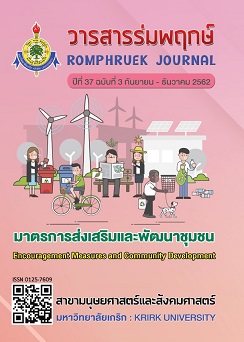The Canonical Correlation Between Work Happiness and Dedication of Community Development Specialist
Main Article Content
Abstract
The objectives of this research were to 1) investigate the level of happiness in work and the level of commitment to work, and to 2) analyze the canonical commitment between the happiness in work and the commitment to work of the community development specialists at Department of Community Development. The samples of this research were three hundred and seventy-three community development specialists at Department of Community Development selected by random sampling. The questionnaire with the five point rating scale was the research tool. The data received were analyzed by percentage, mean, standard deviation, and Canonical Correlation Analysis.
The results revealed that when considering at each aspect of happiness in work, the aspect of work passion received the highest mean score. Next on down were the aspects of recognition, achievement, and human relations, respectively. On the other hand, in terms of commitment to work, the aspect of dedication received the highest mean score. Next on down were the aspects of feeling that the job was important and a part of their lives, and enthusiasm, respectively. In addition, the results of the canonical correlation analysis showed that there were four variables of happiness in work had weight values that affected canonical variables, and there were three variables in commitment to work had weight values that affected canonical variables.
Article Details
Every article published in the Romphruek Journal of the Humanities and Social Sciences is the opinion and point of view of the authors. Thery're not the viewpoint of Krirk University or the editored department. Any part or all of the articles for pablication must be clearly cited.
References
กรมการพัฒนาชุมชน. (2553). ประวัติองค์กร กรมการพัฒนาชุมชน กระทรวงมหาดไทย. (15 พฤษภาคม 2562)
สืบค้นจาก http://www.cdd.go.th.
จิรา เติมจิตรอารีย์. (2550). ทําอย่างไรจึงจะอยู่อย่างมีความสุข. (10 มิถุนายน 2562) สืบค้นจาก http://www.mahidol.ac.th/mahidol/ra/rapc/.
ณัฐชนันท์พร ทิพย์รักษา. (2556). แรงจูงใจในการทํางาน ความบ้างาน และความสุขในการทํางาน.
คณะวิทยาศาสตร์ สถาบันบัณฑิตพัฒนบริหารศาสตร์, กรุงเทพฯ.
ทรงศักดิ์ ภูสีอ่อน. (2551). การประยุกต์ใช้ SPSS วิเคราะห์ข้อมูลงานวิจัย. กาฬสินธุ์ : โรงพิมพ์ประสานการพิมพ์.
ประทุมทิพย์ เกตุแก้ว. (2551). ความสัมพันธ์ระหว่างการรับรู้คุณลักษณะงานความสามารถในการเผชิญ
และฟันฝ่าอุปสรรคกับความสุขในการทำงานของพยาบาลงานการพยาบาลผ่าตัด : กรณีศึกษาโรงพยาบาลรัฐแห่งหนึ่ง.
คณะศิลปศาสตร์ มหาวิทยาลัยธรรมศาสตร์,กรุงเทพฯ.
ปพิชญา วะนะสุข. (2552). ปัจจัยที่มีผลต่อความสุขในการทำงานของตำรวจกองบังคับการอำนวยการ
ตำรวจภูธรภาค 5 จังหวัดเชียงใหม่. คณะบริหารธุรกิจ มหาวิทยาลัยเชียงใหม่, กรุงเทพฯ.
ศรีชล ฉายาพงษ์. (2553). ศึกษาความต้องการพัฒนาตนเองของข้าราชการตำรวจชั้นสัญญาบัตร
และชั้นประทวนกองบังคับการอำนวยการตำรวจภูธรภาค 2 ในสังกัดสำนักงานตำรวจแห่งชาติ.
คณะรัฐศาสตร์และนิติศาสตร์ มหาวิทยาลัยบูรพา, กรุงเทพฯ.
เอกลักษณ์ ตั้งสังขะรมย์. (2555). ความสัมพันธ์ระหว่างความหวังในการทำงานความสุขในการทำงานกับรูปแบบ
สร้างสรรค์ของบุคลากรบริษัทผู้ผลิตอาหารและเครื่องดื่มแห่งหนึ่ง. คณะศิลปศาสตร์ มหาวิทยาลัยธรรมศาสตร์, กรุงเทพฯ.
อรพินทร์ ชูชม. (2557). การวิเคราะห์โครงสร้างความยึดมั่นผูกพันในงาน.
วารสารวิชาการ มหาวิทยาลัยการจัดการและเทคโนโลยีอีสเทิร์น, 11(2), 75 - 79.
Cheanchana, C. (2015). Using Multivariate Statistics for Research : Designing, Analyzing, and
Interpreting. Bangkok : Samlada Printing.
Dubois D. David Rothwell J. William. (2004). “Competency-Based Human Resource management”.
California : Davies-Black Publishing.
Fisher, C. D. (2009). Happiness at work. International Journal of Management Reviews, 22(1),1-35.
Honderich, T. (1995). Oxford Companion to Philosophy. New York : Oxford University Press.
Likert, S. (1961). New patterns of management. New York : McGraw-Hill.
Lloyd, R. (2008). Discretionary effort and the performance domain.
The Australian and New Zealand Journal of Organization Psychology, 1, 22–34.
Maslow A. H. (1987). Motivation and personality. New York : Harper & Brothers.
Manion, J. (2003). Joy at work : Creating a positive workplace. Journal of Nursing Adminis- tration, 33(12), 652-659.
May, D. R., Gilson, R. L., & Harter, L. M. (2004). The psychological conditions of meaningfulness,
safety and avail ability and the engagement of the human spirit at work.
Journal of Occupational and Organizational Psychology, 77, 11-73.
Nunnally, J. C. (1978). Psychometric theory. New York : McGraw-Hill.
Schaufeli, W. B., Taris, T. W., & Van Rhenen, W. (2008). Workaholism, burnout and Engagement : Three of
a kind or three different kinds of employee well-being.
Applied Psychology : An International Review, 57(2), 173 - 203.
The Ken Blanchard Companies. (2009b). From Engagement to Work Passion : A Deeper Un derstanding of the Work Passion Framework. (10 January 2012) Retrieved from
http://www.kenblanchard.com/img/pub/Blanchard_From_Engagement_to_Work_Passion.pdf.
Vance, R. (2006). Employee Engagement and Commitment : A guide to understanding, measuring
and increasing engagement in your organization. Alexandra, VA : SHRM Foundation.
W. B. Schaufeli and A. B. Bakker. (2004). Job demands, job resources and their relationship with
burn out and engagement : A multi-sample study. Journal of Organizational Behavior, 25(1), 293-315.
Yamane. (1967). Statistics : An Introductory Analysis. New York : Harper and Row publishers.


